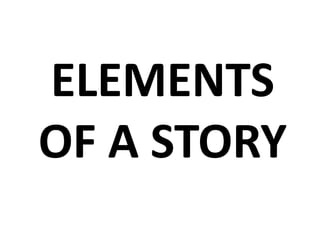
ELEMENTS OF A STORY.pptx
- 2. 1. Setting • This refers to the time and place of the occurrence of the story. These are often times, mentioned at the beginning of the selection. Some settings are directly stated like “long time ago in a remote land,” some are implied or suggestive as common poetic pieces.
- 3. 2. Characters • These are the people, animals or sometimes inanimate objects that play role in the story. The central figure of a story is known as protagonist while those do who cause troubles in the story are called antagonists. Some characters are developed constantly in the story as they play role all throughout various scenes (flat characters.)
- 4. 3. Plot • It is the series of events that happened in the story. A typical plot starts with exposition where the setting and main characters are stated, followed by a rising action where the conflict is introduced, climax or the most exciting part of the story, the falling action where the problem is given solution, and a denouement or the ending of the story.
- 5. 4. Conflict • Conflict, on the other hand, is the problem or the opposition of forces that ties one incident in the story to another. Opposing forces in the story may be between a character and himself, a character and another character, a character and nature or a character and the society.
- 6. 5. Theme • The central idea or concept where the story revolves is called theme. Common themes are love, betrayal, bravery, sacrifice, social problems, politics, nature and etc. In identifying themes, focus on the prevailing concept in the story.
- 7. 6. Lesson • Your takeaways or realizations after reading a story are what you call lessons. Lessons are commonly mistaken as theme, but lessons are often stated in sentences while themes are in words or phrases.
- 8. 7. Point of View • The angle from which a story is told is the point of view of the story. This may be first person or an inside narrator, second person from a conversing narrator, or third person or an outside narrator.
- 9. THE AUTHOR’S PURPOSE • When an author knows his purpose in writing, he will have a clear view of how he will present his ideas to help his readers. An author’s purpose is reflected in the way he writes about a topic.
- 10. •To relate a story or to recount events, an author uses narrative writing (news, non- fictions, travelogues, travel blogs)
- 11. •To tell what something looks like, sounds like, or feels like, the author uses descriptive writing (reviews, personality sketch, descriptive features, etc.)
- 12. •To convince a reader to believe an idea or to take a course of action, the author uses persuasive writing. (editorial, column, propaganda, etc.)
- 13. •To inform or teach the reader, the author uses expository writing.
